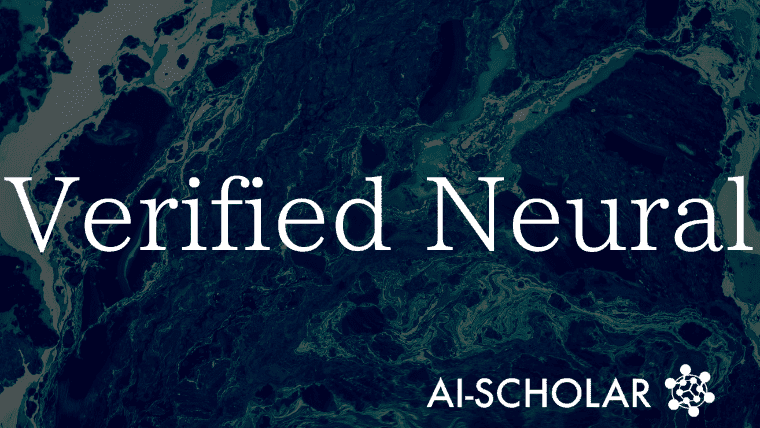
The Compressed Sensing Revolution: Automatic Validation Algorithms Prove Accuracy Of Neural Networks
3 main points
✔️ Development of a new approach to the compressed sensing problem of recovering sparse vectors, utilizing neural networks to solve the problem efficiently and accurately.
✔️ Proving the accuracy of trained neural network models with automated verification algorithms to ensure reliability with minimal human intervention.
✔️ Building and validating models that demonstrate versatility and scalability beyond traditional compressive sensing methods and adaptability to a variety of computational problem settings.
Verified Neural Compressed Sensing
written by Rudy Bunel, Krishnamurthy Dvijotham, M. Pawan Kumar, Alessandro De Palma, Robert Stanforth
(Submitted on 7 May 2024)
Comments: Published on arxiv.
Subjects: Machine Learning (cs.LG); Artificial Intelligence (cs.AI)
code:
The images used in this article are from the paper, the introductory slides, or were created based on them.
Summary
This article describes a breakthrough technology developed by the Google DeepMind research team. It is a new approach called "verifiable neural compressive sensing". This technique solves the problem of accurately recovering sparse vectors from fewer measurements using neural networks. Of particular note is that this process is backed by a fully automated verification algorithm. Previous studies have found it difficult to prove complete accuracy, but this study fills that gap.
We will explore in depth how this technique differs from traditional approaches and what advantages it offers. Applied to concrete mathematical tasks, this new technique may have important implications in the advancement of science and technology.
Related Research
The neural network-based compressed sensing approach in this study is based on a number of prior studies. Compressive sensing was originally developed as a technique to recover sparse signals from a limited number of observations. The foundations of the field were established by Donoho (2006), and various mathematical and engineering applications have since been proposed.
Recent developments in this research area have seen neural networks increasingly being used to solve mathematical and computational problems. In particular, Bora et al. (2017) introduced a new method of compressed sensing using generative models. In this method, a generative model that maps to a higher dimensional space using latent vectors is used to recover sparse signals. In addition, Rout et al. (2023) extended this approach by proposing a technique that uses diffusion models for linear inverse problems.
However, the challenge with these methods has been that neural networks rely either on a specific architecture or on custom human-generated correctness proofs. This study uses an automated verification algorithm to prove that neural networks can solve mathematical tasks without requiring a specific architectural design. This provides a more versatile approach that does not rely on traditional algorithms or human intervention.
These developments represent a major step forward in that neural networks can be applied to concrete computational tasks and that they can be verified automatically. This paves the way for the effective use of neural network verification techniques for a wider range of problems.
Proposed Method
The proposed method developed in this study involves training a neural network in compressed sensing and then proving its accuracy with an automated verification algorithm. The method involves training a neural network specialized to solve the problem of compressed sensing, followed by a verification process to ensure that the trained model functions correctly.
Model Design and Training
The proposed model is designed to recover sparse vectors from linear or binary linear measurements. For this process, it is based on a multi-layer perceptron (MLP) and uses the ReLU activation function. The network is trained to predict the sparse vector support (location of nonzero elements) directly from the measurements. In particular, according to Algorithm 1, adversarial training is applied to optimize the network to perform accurately even for the most challenging cases.

Verification Process
After training, a validation process is performed to prove the correctness of the network. This process ensures that the network outputs the correct support for all given inputs. Specifically, the lower and upper bounds of the network output are calculated and used to mathematically prove that the network provides the correct support (Algorithm 2).

In addition, the branch-and-bound algorithm (Algorithm 3) is used to systematically verify the behavior of the network for all possible inputs and check its correctness.

Experiment
The experiments conducted in this study were designed to evaluate the performance of the proposed neural network model and the efficiency of its validation process. These experiments were designed to verify how effectively the network can recover sparse vectors in different problem settings and how reliably its accuracy can be proven.
Model Performance Evaluation

In the experiment, the model was evaluated in multiple settings with different sparse vector dimensions, number of measurements, and levels of sparsity. Specifically, we checked how accurately the network could recover sparse vectors in scenarios where the vector dimension was less than 50 and the number of measurements was less than the vector dimension. The cactus plot shown in Figure 2 illustrates the time and success rate of the validation process, showing that the model accurately recovers sparse vectors and can reliably prove its results.
Evaluation of Verification Efficiency

To evaluate the efficiency of the validation process of the proposed model, experiments were conducted with both fixed and learned sensing matrices. The purpose of this experiment is to understand the impact of the sensing matrix on the validation time. Figure 3 shows that the verification time is reduced when using the learned sensing matrix, suggesting that this approach may improve verification efficiency.
Introduction of New Constraints

Experiments were also conducted to evaluate the network in scenarios involving new types of measurements, specifically binarized measurements. This experiment investigated how the network adapts to the new measurement type and how it affects the verification time. As shown in Figure 4, it was confirmed that although the introduction of new measurement types adds complexity to the verification process, the proposed model still works effectively and provides accurate results.
These experimental results show that the proposed model is highly adaptive and accurate for different compressed sensing scenarios and that its performance can be validated. Positive results were also obtained for the scalability of the model and the validation process,indicating its applicability to awide range ofproblems.
Conclusion
In this study, we have developed a solution to the compressed sensing problem by training and automatically verifying a neural network. The proposed method enables accurate recovery of sparse vectors and its accuracy can be proven with an automated verification algorithm. The proposed method has been shown to have greater design flexibility and better ability to adapt to different problem settings compared to conventional compressed sensing approaches. Furthermore, the network demonstrated its efficiency and effectiveness throughout the training and verification process.
Future Prospects
Based on the results of this study, similar approaches may be applied to more mathematical and computational problems in the future. Specifically, the model could be extended to higher dimensional problems and problems with different types of constraints. Another important area of research is the improvement of neural network verification techniques themselves, and the development of faster and more efficient verification algorithms is desirable.
Furthermore, the use of verifiable neural networks is expected to find applications in a wider range of fields, such as education, medicine, and finance. In these fields, transparency and accuracy of algorithms are crucial, and the proposed method has the potential to meet those requirements.
Finally, the automatic verification techniques used in this study could be applied to verify other machine learning models and algorithms to further improve the reliability and safety of AI. This is expected to promote social acceptance of AI technology and contribute to building more reliable AI systems.
Categories related to this article





![Zero-shot Learning]](https://aisholar.s3.ap-northeast-1.amazonaws.com/media/October2024/arumenoy-tts-520x300.png)
![TIMEX++] Framework F](https://aisholar.s3.ap-northeast-1.amazonaws.com/media/October2024/timex++-520x300.png)

